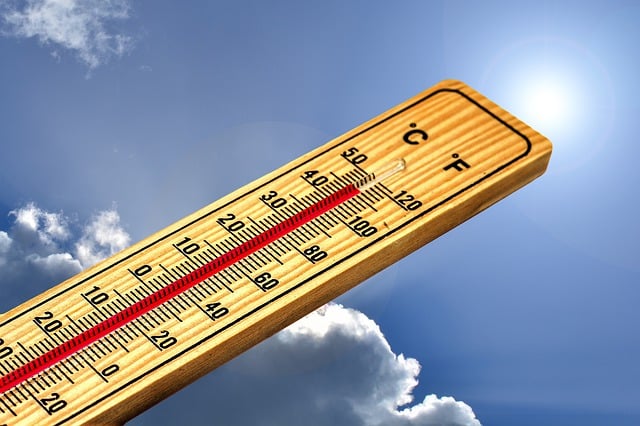Share This Article:

Waltham, MA (WorkersCompensation.com) – The likelihood employees will be injured on the job increases as the temperature rises, a new study from the Workers’ Compensation Research Institute has found.
The study, “Impact of Excessive Heat on the Frequency of Work-Related Injuries,” released on May 9, found that the probability of work-related accidents increases 5 to 6 percent when the temperatures rise above 90 degrees. Additionally, the study found that the effect of heat on the workplace is stronger in the southern U.S. and in the construction industry.
Using data from workers’ compensation claims across 24 states between 2016 and 2021, researchers at WCRI looked at work injuries caused by direct and indirect heat exposure. The report characterized direct injuries where the effect of heat on a worker’s body resulted in heat exhaustion or other issues. Indirect injuries, WCRI said, were ones were heat impaired the cognitive, motor or perception abilities of workers which leads to accidents – like falling off of a ladder on a hot day.
The report found that when compared to a 65 to 70 degree day, days when the temperature rises above 90 see a 5.4 percent increase, and days where the temperature rises above 100 see a 6.1 percent increase in injury incidences.
For workers in the South, that likelihood rises to 9 percent for a 90-95 degree day and 11 percent for a 95 degree or higher day. The research found that in the Northeast, workplace injury incidences are actually less likely when the temperature goes above 100. In the Midwest, the likelihood of injury incidents only rises 2 percent on a 90-95 degree day and 4 percent when the temperature rises about 100.
“It is important to note that workers can adapt, or acclimatize, to excessive heat, which could reduce the incidence of heat-related work accidents,” the report said.
The study found that workplace injuries increase 14 percent for construction workers when the temperature rose to between 90 and 95, and rose 20 percent when the temperatures rose up to 100 degrees. In comparison, workplace injuries were not any higher for workers in the clerical and professional industries when the temperatures rose to between 90 and 95, and actually fell 2 percent when temperatures rose up to 100 degrees.
Other industries with a higher risk of heat injury or illness include mining, quarrying, oil and gas, manufacturing, waste management and remediation services, transportation and warehousing. Agriculture, construction, transportation and warehousing, waste management and remediation services experience the highest rates of heat-related mortality rates, the study found.
The report said it was possible for employees to acclimatize themselves to excessive heat, which could reduce the incidence of heat-related work accidents, and that workers can cope with excessive heat when body cooling - like air conditioning, ventilation or access to shaded areas – is available. But acclimatization and other safety measures may not be enough.
“Despite workers’ acclimatization to heat, the various safety precautions considered in light of public agencies’ standards or recommendations, and the incentives employers may have to protect their employees, there are several reasons for why workers might still be exposed to work-related injuries caused by heat,” the report said.
Researchers recommended employers take greater safety precautions to protect employees who work in hot temperatures.
Excessive heat can also exacerbate existing health problems like asthma, kidney failure and heart disease, the study found. The effect of excessive heat on individual-level factors like age, pharmaceutical use, comorbid health conditions, and the ability to cool at night can also exacerbate the effects of heat on workplace injuries.
Currently, there is no federal occupational health and safety standard in effect to protect workers from heat exposure. OSHA has been working on putting extreme heat and workplace standards into place, but officials said it could take years before a final rule is implemented.
Under existing OSHA standards, employees are responsible for providing workplaces free of known safety and health hazards, including protecting workers from heat-related hazards. OSHA has already outlined several recommendations for employees including ensuring workers acclimatize to the heat, drink cool water often, take rest breaks, take shelter in cool or shaded areas, dress for the heat and watch out for fellow workers, among other recommendations.
AI california case file case management case management focus claims compensability compliance courts covid do you know the rule exclusive remedy florida FMLA glossary check health care Healthcare hr homeroom insurance iowa leadership leadership link medical NCCI new jersey new york ohio osha pennsylvania roadmap Safety safety at work state info technology texas violence WDYT what do you think women's history women's history month workcompcollege workers' comp 101 workers' recovery Workplace Safety Workplace Violence
Read Also
About The Author
About The Author
-
Liz Carey
Liz Carey has worked as a writer, reporter and editor for nearly 25 years. First, as an investigative reporter for Gannett and later as the Vice President of a local Chamber of Commerce, Carey has covered everything from local government to the statehouse to the aerospace industry. Her work as a reporter, as well as her work in the community, have led her to become an advocate for the working poor, as well as the small business owner.
Read More
- Jul 01, 2025
- Frank Ferreri
- Jul 01, 2025
- Liz Carey
- Jun 30, 2025
- Frank Ferreri
- Jun 30, 2025
- Chris Parker
- Jun 30, 2025
- Chris Parker
- Jun 30, 2025
- Frank Ferreri




